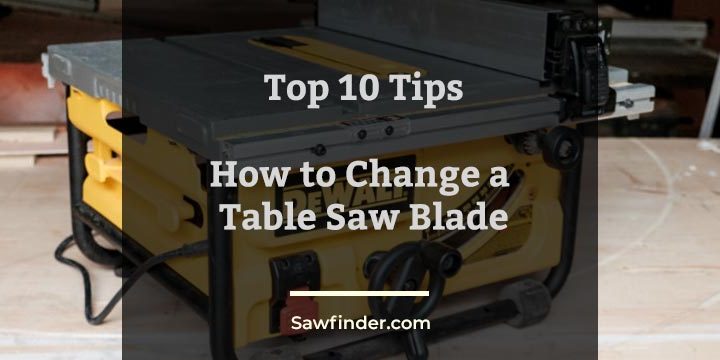How do I change a table saw blade? Table saws are tools that every workshop or a homeowner needs to have when preparing to do various projects. A table saw is very handy when it comes to cutting straight lines on metal, wood, and other materials. However, even if the tool is very durable and effective, with time, the blades need replacement, or you may want to use a different blade for another project. You don’t have to look for another person to help you with the task. The article has information on how to change a table saw blade. Read on for more!
You may need to use a different blade to make dado cuts, smooth cuts, rip cuts, and many more. A single blade cannot make all types of cuts, and so at times, you may need to change the blade. If wondering how to change the blade on the Ryobi table saw or how to change the blade on the Ridgid table saw, you don’t have to worry. Regardless of the type of table saw you have, the procedure is not as hard as people think.
How to Change a Table Saw Blade In 6 Steps
Materials that you need:
- Screwdriver;
- A new table saw blade;
- Hex or Allen wrench;
- A small block of wood;
Step 1- Turning off the power
Locate the power switch on your table saw and switch it off. For extra safety, unplug your saw from the socket to disconnect the saw from the power. Leave your table saw to rest for some minutes so that the power completely drains from the machine.
Bottom-line
You should never change the blade with the power cord on the socket! One wrong move can turn out very fatal.
Step 2- Removing the blade plate
Blade plate is the metal part that rests above the surface of your table saw and so before anything else, put on your gloves for protection. To remove the plate, find a screwdriver and unscrew the two bolts or screws that secure the blade plate, one on the front and the other one at the back.
When removing the plate, it might turn unintentionally and avoid this from happening, place a block of wood against the blade to work as a force of friction. That way you will avoid an accident.
Bottom-line
When you remove the blade plate, it is good to put it away from your working area so that it doesn’t get in the way.
Step 3- Remove the blade
When removing the blade move it to the highest place. To avoid accidents, place a small wood block against the blade to make sure the blade doesn’t turn accidentally. Trace and remove the nut and the washer from the blade by turning the nut clockwise with a wrench. After that, remove the blade slowly!
Bottom-line
Removing the blade is that simple. However, make sure you place it aside as you work to avoid accidents.
Step 4- New blade installation
Now that you already removed the blade take off your gloves to open the packaging of the new blade. Cut around the blade in its packaging with an x-acto knife to safely take it off its packaging. You should never tear or rip the packaging with bare hands since the blade might puncture your hands or fall off the packaging.
Put your gloves back and pick the saw blade. Place the blade into its housing on the table saw and make sure its tips are facing the front side of the saw. Get back the washer and the nut and tighten them back with the use of a wrench in a clockwise direction.
Bottom-line
To completely tighten the blade, use a block of wood to hold the blade while tightening the nuts.
Step 5- Reinstalling the blade plate
Get the screw that was in the machine before and the table plate and fasten them back in place. If you screw them correctly, the blade should not touch any side of the slot that gives space to the blade. In case your blade touches any of the edges, take it off and re-adjust the blade, the washer, or the nut to make sure the blade is in the right place.
After reinstalling the blade correctly, it should look natural. Just the way it was before changing it.
Step 6- Reconnect the power
After reinstalling the blade, it’s time to plug the machine back into the socket and switch on the power. Turn on the saw and run your blade to see if the blade is in the right place and if it is running as usual.
Bottom-line
If your blade runs smoothly, with no shaking or vibration, these are signs of a successful installation. It means that the blade change was successful! Just cut a piece of wood to verify that the blade is working correctly.
There you have it! Now you know how to change a table saw blade. Once you master the trick, it will become a routine activity requiring less effort while making different types of cuts to complete your project.
All the best!

